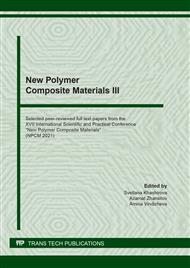[1]
C. Falconi, Systematic design of micro-resistors for temperature control by quasi-simultaneous heating and temperature sensing. Sensor. Actuator, B, (179) (2013) 336-346.
DOI: 10.1016/j.snb.2012.10.065
Google Scholar
[2]
E.S. Park, Resistivity and Thermal Reproducibility of High-Density Polyethylene Heaters Filled With Carbon Black. Macromol. Vater. Eng., (291) (2006) 690-696.
DOI: 10.1002/mame.200500425
Google Scholar
[3]
Y. Bao, L. Xu, H. Pang, D.X. Yan, C. Chem, W.Q. Zhang, J.H. Tang, Z.M. Li, Preparation and properties of carbon black / polymer composites with segregated and double-percolated network structures. J. Mater. Sci., 14 (48) (2013) 4892-4898.
DOI: 10.1007/s10853-013-7269-x
Google Scholar
[4]
Y. Fang, J. Zhao, J.W. Zha, D.R. Wang, Z.M. Dang, Improved stability of volume resistivity in carbon black / ethylene-vinyl acetate copolymer composites dy employing multi-walled carbon nanotubes as second filler. Polymer, 21 (53) (2012) 4871-4878.
DOI: 10.1016/j.polymer.2012.08.035
Google Scholar
[5]
M. Rahaman, T.K. Chaki, D. Khastgir, Control of the temperature coefficient of the DC resistivity in polymer-based composites. J. Mater. Sci., 21 (48) (2013) 7466-7475.
DOI: 10.1007/s10853-013-7561-9
Google Scholar
[6]
D. De Rossi, P.H. Veltink, Wearable technology for biomechanics: e-textile or micromechanical sensors. IEEE Eng. Med. Biol. Mag., (29) (2010) 37-43.
DOI: 10.1109/memb.2010.936555
Google Scholar
[7]
M.I. Abdullin, A.B. Glazyrin, F.F. Basyrov, A.S. Gadeev, A.A. Nikolaeva, Electrically conductive polymer compositions based on polyvinyl acetate. Plastics, 1-2 (2018) 54-57.
Google Scholar
[8]
A. Lukasika, M. Sibinskib, S. Walczak, Relaxation of stresses in polystyrene-carbon microcomposite resistive layers. Mater. Sci. Eng., B. 15 (177) (2012) 1331-1335.
DOI: 10.1016/j.mseb.2012.03.021
Google Scholar
[9]
J. Wang, W. Guo, S. Cheng, Z. Zhang, Structure d Applications of CB / Crystal Fluoride Resin Allou in Self-Regulated Heating Cables. J. Appl. Polym. Sci., (88) (2003) 2664-2669.
DOI: 10.1002/app.12078
Google Scholar
[10]
Y.S. Jong, S.H. Han, E.S. Park, Effects of Thermal Aging on Morphology, Resistivity and Thermal Properties of Extruded High-Density Polyethylene / Carbon Black Heating Elements. Polym. Comp., 7 (32) (2011) 1049-1061.
DOI: 10.1002/pc.21122
Google Scholar
[11]
T. Blythe, D. Bloor, Elecctrical Properties of Polymer. Cambridge University Press, 2005.480 p.
Google Scholar
[12]
T.A. Borukaev, D.S. Gaev, Physical and mechanical properties of composites based on high density polyethylene and carbon black. Applied Physics, 5 (2017) 76-81.
Google Scholar
[13]
G.D. Kudinova, A.M. Bukanov, A.E. Kornev, Effect of carbon black combinations on the electrical conductivity of rubbers. Proceedings of the Moscow Institute of Chemical Technology, 1 (5) (1975) 109-111.
Google Scholar


